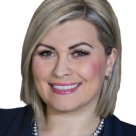An early learning pilot program for preschool-aged children who are deaf and hard of hearing recently opened in Saskatoon and Regina.

The program, Children Communicating, Connecting and in Community, is operated by Saskatchewan Deaf and Hard of Hearing Services and is aimed at reducing communication barriers.
In Bree Sproule and Alyson Hein’s classroom at St. Therese of Lisieux School, the learning dynamic is a bit different.
“As a deaf person, I’m going to be using ASL (American Sign Language) full-time, and then the assistant is here so she can speak,” said lead teacher Bree Sproule, speaking through an interpreter.
“It’s an opportunity for them to socialize, get some exposure to ASL, as well as exposure to English and giving the option to use whatever language they are feeling comfortable with.”
When the program launched in September, they had a lot of ideas.
“We didn’t have anything to start with,” Sproule said. “Kids are coming in with not a lot of language; they don’t understand about deaf culture.”
Like most preschools, it’s a place to learn through play and develop basic interaction skills, but it incorporates that culture, as well.
“It has different things that we do in the community and with each other that’s really different from the hearing world,” said educational assistant Alyson Hein. “It’s really important for them if they’re going to be involved in the community to learn those types of things.”
In class they play games, learning how to properly interact — “how to tap on the shoulder to get somebody’s attention, how to properly make eye contact with people,” Hein said.
“It’s just so important to get that information right at the beginning.”
Four-year-old Isaiah was diagnosed with hearing difficulties at the age of two, and his parents say this class has been a blessing.
Isaiah’s mother, Tara, said the class gives him an opportunity not be frustrated.
“At home we found he would scream — a lot — or he would just get angry because he couldn’t communicate with us,” Tara said. “So if he’s feeling frustrated that he can’t verbalize something, he has the opportunity to try it in sign language.”
The family makes the drive from Waldheim to Saskatoon so Isaiah can attend the class. Before this, he attended a pre-school there.
WATCH BELOW: Hearing impairment not stopping Saskatoon Hilltop player from beating expectations

Ultimately, Hein said it’s the access to the different modes of language that makes the difference.
“If children aren’t allowed that access to language, whether it’s English or ASL it’s definitely frustrating,” she said. “They can’t express their needs and wants and feelings, so having them here where they’re able to use ASL or English, it definitely helps them feel more comfortable expressing.”
In the short time the children have been attending the program, both Sproule and Hein have noticed positive changes.
“They’re more affectionate, they’re more social, they feel comfortable with class and they’re just learning lots of new signs,” Sproule said.
- What is a halal mortgage? How interest-free home financing works in Canada
- Capital gains changes are ‘really fair,’ Freeland says, as doctors cry foul
- Ontario doctors offer solutions to help address shortage of family physicians
- Canada will take bigger economic hit than U.S. if Trump wins election: report
Hein noted seeing improvement when it comes to eye contact — a big struggle at first.
“It’s so important when you’re signing with someone to have that eye contact, and the kids all the time, they wouldn’t look, they couldn’t focus and we’ve definitely seen, especially with story time and stuff, is their visual focus has improved exponentially.”
The class has space for 16 students. Of the nine currently enrolled, three have hearing loss and the others are Children of Deaf Adults (CODA).
Whether the child is hard of hearing or there’s just that connection to the deaf community, Hein said the class gives them a peer group they can connect with.
“Having them here with a group that can sign or speak with them and just accept them for who they are, you can definitely see them growing more confident and happy in the classroom.”



Comments